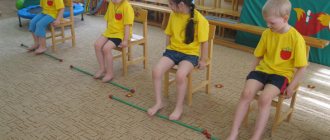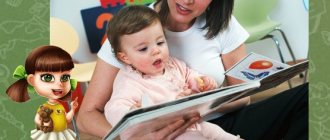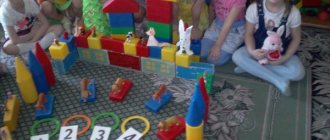Why children love play stretching
The training is accompanied by a role-playing game that captures the imagination and attention. The interactive fairy tale is designed not only to present the correct technique for performing the exercise in an accessible form, but also contains educational elements.
In addition, the game stretching lesson is conducted to rhythmic music. Children can move without restrictions and channel their irrepressible energy into constructive channels. During the lesson, the child performs the exercise as many times as he wants.
Game stretching in kindergarten
Yulia Sevostyanova
Game stretching in kindergarten
of game stretching caught my attention .
Why stretching and what is it ?
Stretching is a method with which you can easily and effectively develop the mobility of body muscles and joints without fear of fractures. In other words, this is a method that allows you to naturally stretch your muscles, and it also allows you to isolate one or another muscle group and train only that one.
Stretching also has a psychological effect: it improves mood, raises self-esteem, and creates a feeling of comfort and calm in general. It increases overall motor activity, which has a beneficial effect on joints and prevents bone fragility. Good flexibility allows you to perform exercises with a greater range of motion, and also ensures good posture and reduces the likelihood of back pain.
Playful stretching classes will help the child develop a sense of rhythm, strengthen muscles, straighten posture, and relieve inhibitions.
Classes using the stretching are conducted in the form of a role-playing or thematic game, which includes 8–9 exercises for various muscle groups. Children pretend to be different animals and perform exercises accompanied by certain pieces of music from classical and folk music.
Imaginative-imitative movements develop motor activity, creative thinking, motor memory, reaction speed, orientation in movement and space, attention, etc. The effectiveness of imitative movements also lies in the fact that through images it is possible to carry out frequent changes in motor activity from various initial ones positions with a wide variety of types of movements, which gives good physical activity to all muscle groups.
When you start telling a fairy tale game, you can act it out at the same time. The game consists of several fragments, which include exercises for static muscle stretching, jumping, stimulation of points on the foot, relaxation to restore breathing, and lasts with the kids for as long as they want. After practicing play stretching, children’s mood and mutual understanding improve. Having learned the exercises, children independently act out a fairy tale and come up with their own fairy tales with movements, thereby developing their creative abilities.
In addition to the general healing effect, the ability to control one’s body and a supply of targeted motor skills allows children to feel strong, self-confident, beautiful, relieves them of various complexes, and creates a sense of inner freedom.
Goal: Preserving and strengthening the health of pupils through technologies for preserving and stimulating health, in particular “ game stretching ”
Tasks:
• Optimize the growth and development of the musculoskeletal system (formation of correct posture, prevention of flat feet)
.
•Improve physical abilities: develop muscle strength, mobility in various joints (flexibility, endurance, speed, strength and coordination abilities.
•Develop mental functions: attention, memory, imagination, mental abilities.
• Develop and functionally improve the respiratory, circulatory, cardiovascular and nervous systems of the body.
• Create conditions for a positive psycho-emotional state of children.
• To develop the ability of emotional expression, freedom and creativity in movements.
• Create conditions for the beneficial influence of music on the psychosomatic sphere of the child.
Slide 9:
Basic principles of organizing classes
• The scientific principle presupposes the construction of classes in accordance with the laws of socialization, mental and physical development of the child.
• The principle of systematicity - Regularity of classes, increasing the load, increasing the number of exercises, complicating the technique of their implementation.
• The principle of gradualism - Teaching exercises from simple to complex, from known to unknown, taking into account the level of preparedness of children. The principle of individuality - Taking into account the characteristics of the age and health status of each child.
• The principle of visualization - Demonstration of physical exercises, figurative story.
• The principle of consciousness and activity presupposes the formation in children of a sustainable interest in mastering new movements, an understanding of the benefits of performing exercises, and the need to perform them.
Structure of classes:
The classes consist of 3 parts.
In the first (introductory)
As part of the lesson, children perform exercises in various types of walking, running, and jumping. Musical and rhythmic compositions can be used as outdoor switchgear. Dance exercises can increase the child’s interest in the activity and emotional mood.
In the second (main)
parts we move on to
game stretching .
Each story material is divided into 2 lessons. In the first lesson, we introduce children to new movements (without music, we consolidate the already known ones. In the second lesson, we improve and clarify the execution of exercises. All exercises are performed to the appropriate music. In the third (concluding)
Part of the solution is the problem of restoring the body after physical exertion and moving on to other types of activities.
Breathing exercises promote faster recovery of the body and are healing in nature. It is important to teach your child to breathe through his nose, to correlate inhalation and exhalation with movements. Relaxation exercises must be included in every lesson so that the child learns to relieve muscle tension after physical activity and relax. This corresponds to relaxation exercises performed in a playful way .
It is advisable to use a piece of music that reflects the nature of the action being performed. The classes use artistic expression, music and personal demonstration. It should be remembered: NOT INTENSITY, BUT SYSTEMATICITY OF EXERCISES IS THE KEY TO SUCCESS WHEN STRETCHING !
But stretching should not be carried out to the detriment of the educational program of preschool education.
Therefore, ways were found to integrate stretching elements at critical moments .
Elements of stretching are integrated into physical education sessions, into invigorating gymnastics complexes, used to develop physical qualities while walking, and, of course, included in physical education classes. Complex story-based exercises in game stretching can be carried out as sports entertainment.
Using play stretching in working with children .
Physical education - short-term physical exercises - is carried out during breaks between classes, as well as during classes that require intellectual stress (speech development, drawing, mathematics, etc.)
.
By including movements in physical education using the method of play stretching, fatigue is relieved and the child’s emotionally positive state is restored.
Joint activity: Unlike classes, it does not have a clear structure, specific program content and is not limited in time. It is organized in the morning and evening hours and is held in a free format. In the evening, game stretching as a joint activity can be organized as circle work.
Independent motor activity: Knowledge and skills, motor skills developed in a child in organized forms of motor activity are successfully transferred into everyday life, into independent motor activity during the day. Due to the fact that play stretching exercises are carried out in a playful way and thus become very interesting and attractive for children, it is quite understandable that preschoolers carry them into their everyday life. These exercises should only be purposefully organized by the teacher, who thinks through the forms and types of activity and makes its adjustments.
Working with parents.
The main educators of the child are the parents. The child’s mood and state of physical comfort depend on how the child’s daily routine is properly organized and how much attention parents pay to the child’s health. The healthy lifestyle of a child, to which he is taught in an educational institution, can either find daily support at home, and then be consolidated, or not be found, and then the information received will be unnecessary and painful for the child, therefore the involvement of parents (legal representatives)
in joint activities throughout the year (a file of exercises, moving folders was created, speaking at family meetings, seminars, open classes, joint entertainment)
Classes using the method I proposed help the child develop a sense of rhythm, strengthen muscles, straighten posture, and relieve inhibitions. After practicing play stretching, children’s mood and mutual understanding improve. Having learned the exercises, children independently act out a fairy tale and come up with their own fairy tales with movements, thereby developing their creative abilities.
This technique gives positive results in physical and speed-strength qualities.
After playing stretching , children's mood improves.
Game stretching is a creative activity in which children live in a world of images, often no less real to them than the surrounding reality.
The implementation of gaming opportunities for the health and development of the child is the essence of stretching .
Basic principles of doing exercises
Basic requirements for game stretching classes:
» Regularity. Only systematic training will bring positive results. » Adequacy. The degree of load should correspond to the age and capabilities of the child. " Availability. The exercises should be understandable to the child. » Gradualism. Over time, more complex and unfamiliar exercises are added to the training complex. » Consolidation of skills. The exercise is performed several times. The initial number of repetitions is 4. » An individual approach requires taking into account the characteristics of the age, health and wishes of each individual child.
How to do the exercises correctly
For game stretching there are the following important rules:
- Visibility. Exercises should fit as comfortably as possible into the invented fairy tale. They are demonstrated by the teacher or one of the children;
How to do the exercises correctly
- Availability. The entire complex of game stretching should contain familiar and simple movements. If you teach new exercises, then you need to go from simple to more complex;
- Systematicity. classes for preschool children should be conducted regularly, gradually increasing the number of repetitions and level of difficulty;
- Fixing skills. The child needs to be taught to do exercises not only in kindergarten, but also at home. Stretching should be done so that the number of repetitions and the load on the muscles gradually increases;
- Individual approach. In the process of play stretching , you need to remember that each child in kindergarten is individual. Exercises should be based on your health, age and character;
- Consciousness. Each lesson should begin with the teacher talking about the benefits of exercise. How, thanks to playful stretching, children will gain flexibility, become stronger and more resilient. Older children need to be explained which muscles will be used during the training process.
The main thing to remember is that any training should not cause damage to the body of both a child and an adult.
An example of a fairy tale for stretching games for preschoolers
Tale about the kitten Snowball:
Once upon a time there lived an affectionate and playful kitten, Snowball. Warm up. Perform the “Cat” exercise: get on all fours, alternately arch your back and bend back.
One day Snowball was sleeping soundly on the sofa. But now, the sun has risen and it’s time to wake up. Snowball opened his eyes and sweetly stretched his whole body. Stretching is performed: sitting on your knees, raise your arms above your head and stretch upward. Then sit on your heels and stretch your arms forward.
Snowball easily jumped off the sofa and ran into the attic to play. Perform the “Running” exercise: lying on your stomach, bend your knees and alternately touch your buttocks with your heel.
Snowball climbed the stairs and saw that there was a huge lock hanging on the attic door. Perform the “Lock” exercise: bend your arms, place one behind your head, and the other behind your back. Clasp your fingers.
Snowball looked sadly at the door. However, the restless kitten’s attention was soon attracted by the flashing of bright butterflies outside the window. Perform the “Butterfly” exercise: sitting on your buttocks, bend your knees and bring your feet together. Pull your feet as close to your pelvis as possible.
Snowball quickly ran down the stairs. The exercise “Running” is performed. The kitten ran among the fragrant flowers, trying to catch bright butterflies. The exercise is performed: sitting on your heels, bend your elbows and wave them, imitating the movement of the wings of a butterfly.
And then Snowball heard a strange sound in the grass and hid in fear. Plucking up courage, the kitten turned around and saw Little Frog. Perform the “Frog” exercise: sitting, bend your knees and spread them. Close your feet. Shift your weight to your hands. Lower the pelvis to the floor.
The Frog's croaking seemed very funny to Ryzhik. The kitten couldn't help but laugh and began to roll around on the grass. Perform the “Roller” exercise: lying on your back, bend your knees, clasp them with your hands and press them to your chest. Round your back and perform several rolls.
The frog and Ryzhik became friends and happily jumped around the garden together all day. Children jump on the spot.
When the sun had already begun to set, the tired Snowball wandered home. Children walk in place.
The influence of play stretching on the motor activity of preschool children
Pay due attention to the physical education of your children. It is important to know that during preschool childhood, thanks to the competent organization of the pedagogical process, the child’s good health is established and correct coordination of movements is established.
This aspect is of enormous importance for the harmonious formation of the human personality and its comprehensive development. This article examines the influence of play stretching on the motor activity of preschoolers, and also provides a number of valuable recommendations for the successful organization of classes.
Exercises
Sun
» IP: standing, legs apart. » Raise your arms above your head. » Bend to the side, trying to reach your heel with your palm.
Airplane
» IP: sitting on your knees. » Straighten one leg and move it back. » Spread your arms to the sides.
boat
» IP: lying on your stomach. » Raise your arms and legs off the floor. » Rock back and forth.
Tree
» IP: standing, feet shoulder-width apart. » Raise your arms above your head and join your palms. » Bend your knees slightly
Snake
» IP: lying on your stomach. » Place your hands in front of you. » Transfer your weight to your palms or forearms. » Raise your chest off the floor.
Bike
» IP: lying on your back. » Bend your knees and lift them above the floor. » Simulate riding a bicycle.
Bunny
» IP: support on the palms and feet. » Moving your palms towards your feet, try to stand up straight. » Do not lift your heels off the floor.
Run
» IP: standing, feet closed. » Run in place, raising your knees high.
Snowman (relaxation)
» IP: lying on your back. “The pose can be any.
Game stretching in the second junior group
Olga Myasnikova
Game stretching in the second junior group
A fairy tale about a little kitten Kuzya.
— Teach children various types of imitation movements of play stretching .
— Develop muscle elasticity and coordination of movements.
— Cultivate endurance, diligence, and a sense of rhythm.
1. Organizational moment.
Educator: guys, today I want to tell you a fairy tale about the little kitten Kuzya, but first we need to do a warm-up, do you agree?
2. Introductory part: to the music “Merry Mouse”
Walking, running, walking on toes, on heels, side step, running on toes.
ORU: to the song “Radiant Sun”
, children perform exercises based on the lyrics of the song.
3. Main part: music from the cartoon “Masha and the Bear”
,
“Three Wishes”
,
“About Friendship”
Educator: now you and I will take the magic rugs and sit down more comfortably.
Pose "Indian"
, in which children stay all the time between exercises.
I. p.: sit on your heels, put your hands on your hips, spread your elbows to the sides. Imagine yourself as an Indian leader with a proud posture and watch it all the time.
— The kitten was sleeping on the sofa and suddenly heard a sound in the attic.
He closed his eyes, but the sound repeated again . Kuzya jumped off the sofa and went to the stairs that led to the attic: exercise “Walking”
I. p.: sit down, take a “right angle”
: the back is straight, the legs lie together on the floor, the toes are extended, the arms are behind the back and the back is supported high. Alternately pull your toes towards you.
— The ladder was very high, and the kitten began to climb up it: exercise “Bicycle”
I.p.: lying on your back, arms along your body, with your toes pointed, you need to lift your legs off the floor and alternately straighten and bend your legs, without lowering them to the floor.
— When Kuzya climbed into the attic, he looked around and saw a big cat: exercise “Cat”
Game stretching for preschool children with sets of exercises
Most parents are concerned about the health of their children, namely how to distract their child from the computer, tablet and teach them to play sports. Stretching for children can help with this . Stretching will be especially useful for a developing body, as it strengthens muscles and develops endurance and flexibility.
Game stretching for preschool children with sets of exercises
Do not forget that during stretching, the child will learn to maintain correct posture. To make classes interesting, preschool institutions conduct play stretching for children .





